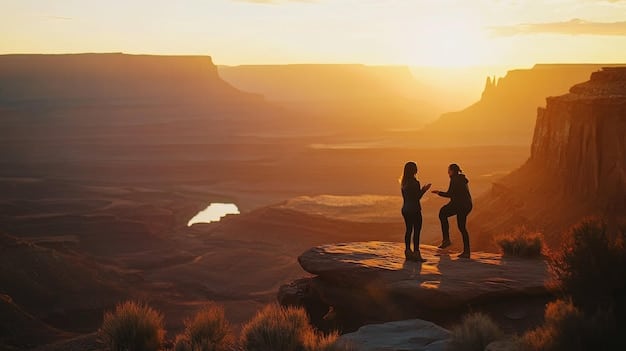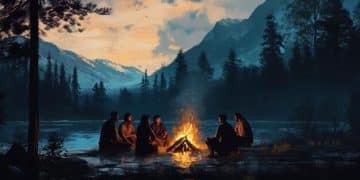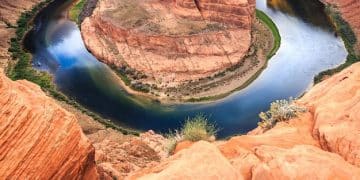Plan the Perfect Family Vacation to US National Parks

Planning a family vacation to US National Parks involves balancing educational experiences with fun activities while prioritizing safety and comfort for all ages, creating unforgettable memories.
Dreaming of an unforgettable family adventure? Look no further than the breathtaking landscapes of the US National Parks! Planning a family vacation to US National Parks: Tips for Keeping Kids Entertained and Safe can seem daunting, but with some preparation, it can be an incredible experience for everyone.
Choosing the Right National Park for Your Family
Selecting the perfect national park is the first step in crafting an amazing family vacation. Consider your children’s ages, interests, and physical abilities when making your choice. Some parks offer easier trails and more accessible attractions, making them ideal for younger children or those with mobility limitations.
Think about what your family enjoys doing. Are you all about hiking, wildlife viewing, or exploring historical sites? Some parks are known for their stunning geological formations, while others boast abundant wildlife or fascinating cultural history. Matching your family’s interests to the park’s offerings will ensure everyone has a great time.
Consider the Season and Weather
Weather can significantly impact your national park experience. Summer is a popular time to visit, but it can also be extremely hot, especially in desert regions. Spring and fall offer milder temperatures and fewer crowds, making them ideal times for hiking and outdoor activities. Winter can be beautiful in some parks, but it’s important to be prepared for snow and ice.
Research Accessibility and Amenities
Before you finalize your choice, research the park’s accessibility and amenities. Ensure the park has suitable lodging options, whether you prefer camping, staying in a park lodge, or renting a cabin nearby. Also, check for available services like restaurants, restrooms, and visitor centers. Knowing what to expect will help you plan accordingly and avoid any unpleasant surprises.
- Yosemite National Park: Offers stunning views, hiking trails for all levels, and ranger programs for kids.
- Grand Canyon National Park: Provides accessible viewpoints, mule rides, and educational exhibits.
- Acadia National Park: Features carriage roads perfect for biking, scenic drives, and diverse wildlife.
- Yellowstone National Park: Boasts geysers, hot springs, and abundant wildlife, including bison and elk.
By carefully considering your family’s interests, the season, and the park’s amenities, you can choose a national park that everyone will love. Remember to book accommodations and activities in advance, especially during peak season.
Planning Your Accommodation and Transportation
Once you’ve chosen your destination, secure your accommodation and plan your transportation. National park lodges and campgrounds often book up months in advance, particularly during peak season. Consider alternative accommodations outside the park, such as hotels, motels, or vacation rentals, if you can’t find lodging within the park.

Think about how you’ll get around the park. Some parks have shuttle services that can transport you between different attractions, while others require you to drive your own vehicle. If you plan to drive, be prepared for limited parking and potentially congested roads, especially during busy times.
Booking Accommodation in Advance
Reservations are crucial when planning a family vacation to US National Parks. Booking your accommodation well in advance ensures you have a comfortable place to stay. Check the park’s website or reputable booking platforms to find available options. Be aware of cancellation policies and any restrictions that may apply.
Transportation Options within the Park
Explore the various transportation options available within the park. Many national parks offer shuttle services, which can be a convenient way to get around without having to worry about parking. Some parks also have bike rentals, allowing you to explore scenic trails at your own pace. Consider the availability and cost of these options when planning your itinerary.
- National Park Lodges: Provide convenient access to park attractions but book up quickly.
- Campgrounds: Offer an affordable option for families who enjoy camping.
- Shuttle Services: Reduce traffic congestion and provide easy access to popular destinations.
- Bike Rentals: Allow you to explore scenic trails and get some exercise.
Planning your accommodation and transportation carefully will ensure a smooth and enjoyable family vacation to US National Parks. Consider all available options and book in advance to avoid disappointment.
Packing Essentials for a National Park Trip with Kids
Packing the right gear can make all the difference on a national park vacation with kids. Be prepared for changing weather conditions and various outdoor activities. Essential items include comfortable hiking shoes, layers of clothing, sunscreen, insect repellent, and a first-aid kit.
Don’t forget to pack snacks and water to keep everyone energized and hydrated throughout the day. Binoculars can enhance wildlife viewing experiences, and a camera will help you capture unforgettable memories. Also, consider bringing educational materials like field guides and maps to learn more about the park’s flora and fauna.
Clothing and Footwear
Pack layers of clothing to adapt to changing weather conditions. A lightweight jacket, fleece sweater, and rain gear are essential for staying comfortable. Hiking shoes should be sturdy and provide good support. Consider bringing extra socks to keep feet dry.
Safety and Health Supplies
Prioritize safety by packing a comprehensive first-aid kit with essentials like bandages, antiseptic wipes, pain relievers, and any necessary medications. Sunscreen with a high SPF is crucial for protecting skin from the sun’s harmful rays. Insect repellent will help prevent mosquito bites and other insect-related issues.
- Hiking Shoes: Provide comfort and support for walking and hiking.
- Sunscreen: Protects skin from harmful UV rays.
- Insect Repellent: Keeps mosquitoes and other insects away.
- First-Aid Kit: Addresses minor injuries and medical needs.
Packing the right essentials will help ensure a safe, comfortable, and enjoyable family vacation to US National Parks. Consider the specific activities you plan to engage in and pack accordingly.
Keeping Kids Entertained on the Trail
Keeping kids engaged and entertained on the trail can be a challenge, but with a little creativity, you can make hiking fun for the whole family. Plan age-appropriate hikes and break them up into manageable segments. Incorporate games, scavenger hunts, and educational activities along the way.
Encourage children to participate in nature observations, such as identifying different types of plants and animals. Tell stories about the park’s history or ecology. Bring along a small sketchbook and colored pencils for them to document their observations and experiences.
Games and Activities
Incorporate games and activities to make hiking more enjoyable for kids. Try a scavenger hunt where they search for specific items like a pinecone, a feather, or a certain type of rock. Play “I Spy” using natural elements. Tell stories or sing songs to pass the time.

Educational Opportunities
Take advantage of educational opportunities along the trail. Point out different types of plants and animals and explain their importance in the ecosystem. Discuss the park’s history, geology, and cultural significance. Use field guides to identify different species.
- Scavenger Hunts: Encourage exploration and observation.
- Nature Observations: Foster appreciation for the natural world.
- Storytelling: Engage imaginations and pass the time.
- Sketching: Document observations and experiences.
Keeping kids entertained on the trail is essential for a successful family vacation to US National Parks. With a little planning and creativity, you can turn hiking into a fun and educational experience for everyone.
Prioritizing Safety in National Parks
Safety should always be a top priority on a national park vacation, especially when traveling with children. Educate your family about potential hazards, such as wildlife encounters, steep cliffs, and changing weather conditions. Stay on marked trails and follow park regulations.
Carry a map and compass or GPS device and know how to use them. Be aware of your surroundings and watch out for hazards. Store food properly to avoid attracting animals. Supervise children closely and keep them within sight at all times.
Wildlife Encounters
Learn how to respond to wildlife encounters. Keep a safe distance from animals and never feed them. Store food in bear-resistant containers. If you encounter a bear, make noise and slowly back away. Avoid approaching or disturbing animals, especially mothers with young.
Trail Safety
Stay on marked trails and be aware of potential hazards, such as steep drop-offs, uneven terrain, and slippery surfaces. Wear appropriate footwear and carry a first-aid kit. Let someone know your hiking plans and expected return time. Be prepared for changing weather conditions and adjust your plans accordingly.
- Wildlife Safety: Maintain a safe distance from animals and store food properly.
- Trail Safety: Stay on marked trails and be aware of potential hazards.
- Weather Awareness: Be prepared for changing conditions and adjust your plans accordingly.
- Supervision: Closely supervise children at all times.
Prioritizing safety is crucial for a successful family vacation to US National Parks. By educating your family and taking precautions, you can minimize risks and enjoy a safe and memorable experience.
Creating Lasting Memories: Photography and Journaling
Documenting your family’s national park adventure through photography and journaling is a wonderful way to create lasting memories. Encourage everyone to take photos of their favorite sights and experiences. Write down memorable moments, funny stories, and personal reflections in a travel journal.
Share your photos and stories with friends and family and create a scrapbook or photo album to preserve your memories. These keepsakes will serve as a reminder of your incredible adventure and inspire future travels.
Capturing the Moment
Bring a camera to capture the beauty of the national parks and your family’s experiences. Encourage everyone to take photos of their favorite sights, activities, and memories. Experiment with different angles, compositions, and lighting to capture unique perspectives.
Journaling and Storytelling
Keep a travel journal to document your family’s adventures. Write down memorable moments, funny stories, and personal reflections. Encourage children to participate by drawing pictures or writing about their experiences. These journal entries will become treasured keepsakes.
- Photography: Capture the beauty of the national parks and your family’s experiences.
- Journaling: Document memorable moments, funny stories, and personal reflections.
- Scrapbooking: Create a visual record of your adventure.
- Sharing: Share your photos and stories with friends and family.
Creating lasting memories through photography and journaling is a rewarding way to commemorate your family vacation to US National Parks. These keepsakes will allow you to relive your adventure for years to come.
| Key Area | Brief Description |
|---|---|
| ✅ Choosing a Park | Selecting the right park based on interests and accessibility. |
| 🏨 Accommodation | Booking lodging in advance, considering park lodges or camping. |
| 🎒 Packing | Essential items for comfort and safety on the trails. |
| 🏞️ Entertainment | Activities to keep kids engaged and entertained during hikes. |
FAQ
▼
The best time depends on the park, but generally, spring and fall offer milder temperatures and fewer crowds, making them ideal for family visits. Summer can be hot and crowded.
▼
It’s recommended to book accommodation as early as possible, especially for popular parks and during peak season. Aim to book several months in advance to secure your preferred lodging.
▼
Maintain a safe distance, never feed animals, and store food properly to avoid attracting them. If you encounter a bear, make noise and slowly back away without running.
▼
Some activities, like certain hikes or ranger programs, may have age or height restrictions for safety reasons. Check the park’s website or visitor center for specific requirements.
▼
Comfortable hiking shoes, layers of clothing, sunscreen, insect repellent, a first-aid kit, snacks, and water are essential. Binoculars and a camera can also enhance the experience.
Conclusion
Planning a family vacation to US National Parks requires careful preparation and consideration. By choosing the right park, booking accommodation in advance, packing appropriately, prioritizing safety, and keeping kids entertained, you can create unforgettable memories that will last a lifetime.





